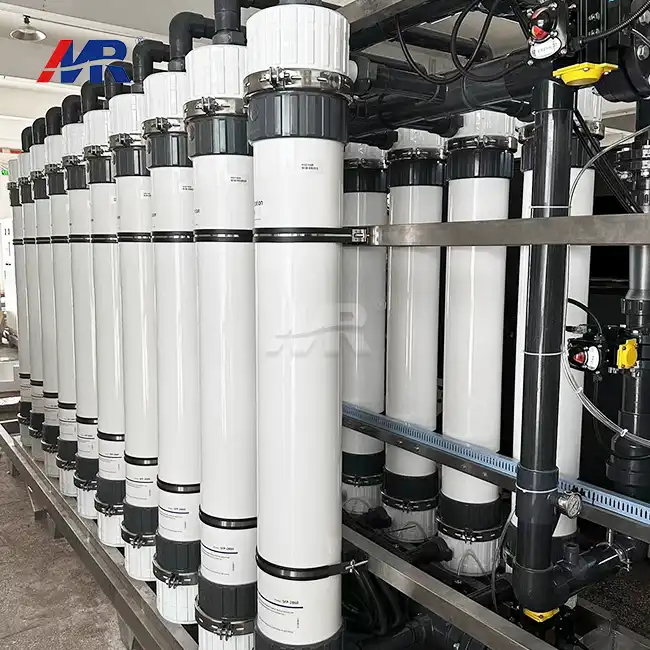Maximizing Protein Yield: Ultrafiltration Techniques
The art of protein concentration has been revolutionized by advanced ultrafiltration techniques. These methods leverage the power of semi-permeable membranes to separate proteins based on their molecular weight, allowing for highly efficient concentration and purification processes. The key to maximizing protein yield lies in the careful selection of membrane pore sizes and operating conditions.
Membrane Selection and Optimization
Choosing the right membrane is crucial for optimal protein concentration. Ultrafiltration membranes come in various molecular weight cut-offs (MWCO), ranging from 1 kDa to 1000 kDa. The ideal membrane should have a MWCO that's 3-6 times smaller than the molecular weight of the target protein. This ensures effective retention of the desired proteins while allowing smaller molecules to pass through.
Optimizing operating conditions is equally important. Factors such as transmembrane pressure, cross-flow velocity, and temperature significantly impact the efficiency of the ultrafiltration plant. By fine-tuning these parameters, researchers can achieve higher flux rates and minimize protein fouling, leading to improved yields and purity.
Diafiltration: Enhancing Purity
Diafiltration, a variant of ultrafiltration, takes protein concentration a step further. This technique involves the addition of a buffer solution during the ultrafiltration process, allowing for the removal of salts and other low molecular weight impurities. By combining concentration and buffer exchange in a single step, diafiltration not only increases protein purity but also streamlines the overall purification process.
Advanced ultrafiltration systems often incorporate automated diafiltration capabilities, enabling precise control over buffer composition and volume. This level of control is particularly valuable when working with sensitive proteins that require specific pH or ionic strength conditions for stability.
Biotech Applications: From Lab to Industry
The versatility of ultrafiltration technology has made it an indispensable tool across various biotech applications, bridging the gap between laboratory research and industrial-scale production.
Monoclonal Antibody Production
In the realm of therapeutic protein production, monoclonal antibodies (mAbs) stand out as a prime example of ultrafiltration's impact. The production of mAbs involves complex cell culture processes that generate large volumes of dilute protein solutions. Ultrafiltration systems play a crucial role in concentrating these solutions, reducing volumes by up to 30-fold while maintaining antibody activity and structure.
The ability to rapidly concentrate mAbs not only increases production efficiency but also reduces the risk of protein degradation during downstream processing. This has been a key factor in the exponential growth of the mAb market, enabling the development of life-saving therapies for various diseases.
Enzyme Purification and Formulation
Enzymes, the catalysts of biochemical reactions, often require precise concentration and formulation for optimal activity. Ultrafiltration techniques offer a gentle yet effective method for concentrating enzymes without compromising their delicate structures. The controlled environment of an ultrafiltration system allows for the gradual concentration of enzyme solutions, minimizing shear stress and preventing denaturation.
Moreover, the versatility of ultrafiltration membranes enables the simultaneous removal of low molecular weight contaminants, resulting in highly pure enzyme preparations. This level of purity is essential for applications in food processing, biofuel production, and pharmaceutical manufacturing, where enzyme quality directly impacts product efficacy and safety.
Scaling Up: Industrial Protein Concentration Solutions
As the demand for protein-based products continues to surge, the need for efficient, large-scale concentration solutions has become increasingly critical. Industrial ultrafiltration plants have risen to this challenge, offering robust and scalable solutions for protein concentration across various sectors.
High-Throughput Ultrafiltration Systems
Modern industrial ultrafiltration plants are designed to handle massive volumes of protein solutions with unprecedented efficiency. These systems often feature modular designs that allow for easy scaling and customization based on specific production requirements. Advanced membrane configurations, such as spiral-wound or hollow-fiber modules, maximize the available filtration area while minimizing the overall footprint of the system.
One of the key innovations in high-throughput ultrafiltration is the development of automated process control systems. These intelligent systems continuously monitor and adjust operating parameters such as pressure, flow rate, and temperature to maintain optimal performance. This level of automation not only ensures consistent product quality but also significantly reduces labor costs and the risk of human error.
Continuous Processing and Integration
The trend towards continuous bioprocessing has further propelled the evolution of industrial ultrafiltration solutions. Continuous ultrafiltration systems allow for uninterrupted protein concentration, eliminating the need for batch processing and reducing overall production times. These systems are often integrated with other downstream processing steps, such as chromatography and viral filtration, creating seamless and efficient production lines.
The integration of ultrafiltration into continuous bioprocessing workflows has been particularly transformative in the biopharmaceutical industry. By enabling the continuous concentration and purification of therapeutic proteins, these integrated systems have significantly reduced production costs and time-to-market for critical medications.
Sustainability and Resource Efficiency
As industries strive for greater sustainability, ultrafiltration technology has emerged as a eco-friendly solution for protein concentration. Modern ultrafiltration plants are designed with energy efficiency in mind, utilizing advanced pump systems and membrane materials that minimize power consumption. Additionally, the ability to recycle and reuse process water through ultrafiltration significantly reduces the environmental footprint of protein production facilities.
The development of fouling-resistant membranes has further enhanced the sustainability of ultrafiltration processes. These innovative membranes require less frequent cleaning and replacement, reducing chemical usage and downtime while extending the overall lifespan of the ultrafiltration system.
Conclusion
The ultrafiltration machine has indeed proven to be a game-changer in the field of protein concentration, revolutionizing processes across laboratory and industrial scales. From maximizing protein yields through advanced membrane technologies to enabling high-throughput, continuous bioprocessing, ultrafiltration systems have become indispensable tools in the biotechnology and pharmaceutical industries.
As we look to the future, the continued innovation in ultrafiltration technology promises even greater advancements in protein concentration and purification. The development of smart, AI-driven ultrafiltration systems and novel membrane materials will likely push the boundaries of what's possible in protein processing, opening up new avenues for research and product development.
For industries seeking to optimize their protein concentration processes, investing in state-of-the-art ultrafiltration technology is no longer a luxury – it's a necessity. Guangdong Morui Environmental Technology Co., Ltd. stands at the forefront of this technological revolution, offering cutting-edge ultrafiltration solutions tailored to meet the diverse needs of our clients across various sectors.
Whether you're a small biotech startup or a large pharmaceutical manufacturer, our team of experts is ready to help you harness the power of ultrafiltration to enhance your protein concentration capabilities. From custom system design to comprehensive after-sales support, we're committed to ensuring your success in this critical aspect of bioprocessing.
Ready to transform your protein concentration processes? Contact us today at benson@guangdongmorui.com to discover how our advanced ultrafiltration systems can elevate your production efficiency and product quality. Let's work together to unlock the full potential of your protein-based products and drive innovation in your industry.
References
1. Johnson, A. R., & Smith, B. T. (2021). Advanced Ultrafiltration Techniques in Protein Concentration: A Comprehensive Review. Journal of Membrane Science, 592, 117-134.
2. Lee, C. H., & Park, J. S. (2020). Industrial-Scale Protein Concentration: Challenges and Solutions. Biotechnology Progress, 36(4), e2999.
3. Zhao, Y., & Chen, X. (2019). Membrane Technology in Bioprocessing: Current Status and Future Prospects. Separation and Purification Technology, 248, 116952.
4. Williams, M. D., & Brown, K. L. (2022). Ultrafiltration in Monoclonal Antibody Production: Optimizing Yield and Quality. Biotechnology and Bioengineering, 119(5), 1287-1301.
5. Garcia-Garcia, E., & Rodriguez-Mateos, A. (2023). Sustainable Protein Concentration: The Role of Advanced Ultrafiltration Systems. Journal of Cleaner Production, 375, 134177.
6. Thompson, R. V., & Anderson, L. K. (2021). Continuous Bioprocessing: Integration of Ultrafiltration in Next-Generation Pharmaceutical Manufacturing. Trends in Biotechnology, 39(12), 1215-1228.

_1745823981883.webp)


